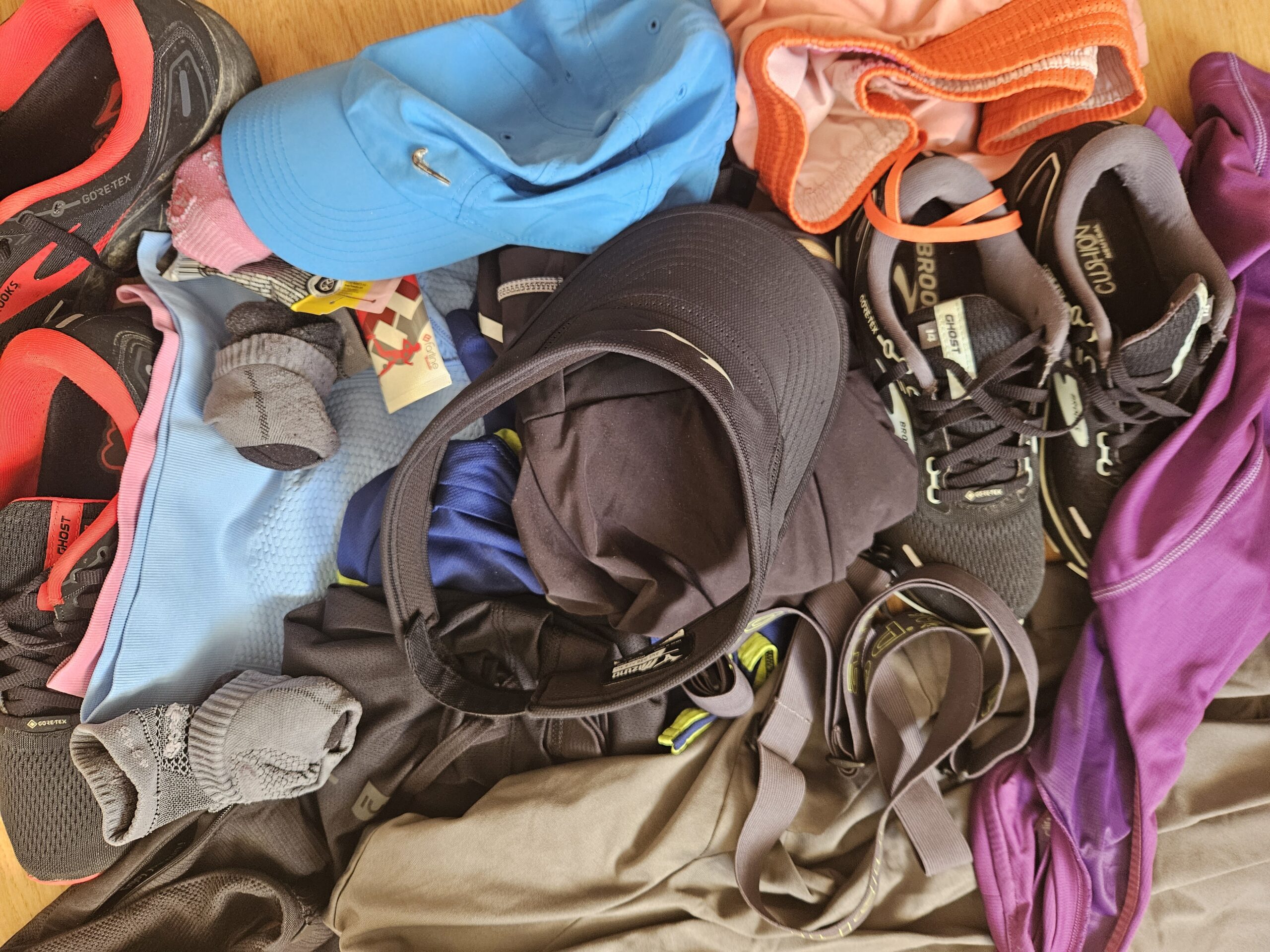
Heat, sweat and tears …
Running when the asphalt shimmers isn’t just tough—it’s a different sport. But the right kit can turn sweat misery into a sun‑soaked triumph!
Here’s some advice and gear recommendations if you are running in hot climates, as we do very often: both in our hometown Barcelona in summer, or around the world.
What you will find in this article:
- All you need to know – your guide to hot weather running gear
- The gear in action in adventurous races
- Frequently Asked Questions
- What we finally pack
- Summary of recommendations
🌬️ Cooling & Moisture‑Wicking Apparel
Breathable Shirts & Tanks
Look for ultra-lightweight, synthetic or nylon-poly blends with mesh zones—these pull sweat away and dry fast. Popular picks include Patagonia Capilene Cool, rabbit EZ Tee, and Path Projects Wadi tank.
Lightweight Shorts & Liners
Go featherweight: Patagonia Strider Pro and Tracksmith Session are just 3–4 oz, built-in liners minimize chafing, and zip pockets secure your essentials.

UPF Sun Shirts & Sleeves
Running sleeves (e.g., Path Projects Moab) offer cooling evaporation with sun protection. Opt for UPF 30+ fabric—think long runs, not just style!
💧 Hydration & Electrolytes
- Hydration Packs/Vests: Ideal for long, hot runs. Look for 1–2 L vests with cooling insulation.
- Handheld Bottles & Belts: Great for shorter jaunts—easy to sip from on the move.
- Electrolyte Tablets/Powders: Crucial for hot runs—replenish lost sodium and potassium.
🕶️ Sun Protection Essentials
- Hat or Visor: Bolster breathability with mesh panels and moisture-wicking sweatbands.
- Sunglasses: Wraparound UV‑blocking lenses help reduce glare and effort.
- Sports Sunscreen: SPF 30+, sweat resistant—don’t forget reapplication.
👟 Footwear & Cooling Accessories
- Breathable Shoes: Engineered mesh uppers; choose lighter models like Hoka Clifton, Saucony Kinvara, or Brooks Sherpa 5″ shorts-style grip.
- Cooling Towels & Neck Wraps: Wet them, freeze them, then bring instant chill to your neck.
- Arm Sleeves: Wet them pre-run—the airflow does the rest.
⌚ Tech & Extras
- Heat‑Focused GPS Watch: Devices like Garmin Fenix 7 track heat acclimation and stress.
- Audio & Safety: Bone-conduction earbuds stay sweat-resistant and lets you stay alert.
- Cooling Caps & Ice-pocket Hats: Nathan Run Cool Stash allows ice cubes over the brow.
Our experience running in hot climates 🌡️
Running in heat is one thing—but add humidity, sun, sand, or jungle moisture, and it becomes a whole different challenge. Here’s what we’ve learned from real-world experiences—from tropical beaches to blistering deserts.
Tropical Jungle & Coastal Heat
- Humidity is the boss: Air saturation (often 70–90% humidity) makes even modest temperatures feel like a sauna—sweat barely evaporates, making thermoregulation hard.
- Breathing gets laborious: Running in Cartagena or Singapore feels thick; your chest tightens, legs feel heavy, and heart rate shoots up despite easy pacing.
- Hydration & electrolytes are mission-critical: On a run in Koh Samui or Cartagena, carrying water and electrolytes—ideally in small sips—can make the difference between slogging and surviving.
- Shade, pacing & time of day matter: We usually run at dawn or dusk, when temperatures dip slightly, and seek tree cover or coastal breezes to avoid midday heat trapped in concrete.
Desert & Dry Heat
- Sun beats down relentlessly: Under cloudless skies, desert sun feels intense—sand and rocks reflect heat back up while air remains arid (humidity < 10%).
- Sweat evaporates too well: You may not feel sweaty, but fluid loss is rapid—your mouth dries out, and you can become dehydrated before noticing.
- Hydrate proactively: In Lake Abbe or Riyadh, we start our runs well-hydrated, carry electrolytes, and sip regularly—much like elite explosive environmentscape support.
- Sun-protective gear is essential: Wide-brimmed hats, UPF clothing, sunglasses, and sunscreen help protect against direct radiation, especially in the Petra Desert Marathon.
Spotlight: Destinations we’ve Run In
- Cartagena de Indias: Intense humidity, narrow old-town streets trap heat—requires super early runs, electrolyte-heavy hydration, and low pace. We started very early but, even so, we almost did not finish as we forgot to hydrate properly.
- Canaima (Venezuela): Jungle trails outside Angel Falls—air so thick you feel like you’re running through soup; shade saves your sanity, and frequent water stops are a must. However, it is a great experience!

- Singapore: Equatorial humidity plus urban concrete. We ran very early, otherwise, it wouldn’t have been possible.
- Koh Samui: You can mix beach runs with jungle shade trails, we opted for the first, despite the difficulty of running on sand.
- Lake Abbe, Djibouti: Lunar desert landscape, minimal shade, wind blowing salty dust—your throat sockets dry quickly. It is mandatory to run very early or very late, but, still, always start fully hydrated, sip small and often.
- Riyadh: Urban desert heat, pavement glare. Temperatures can go up to 40 °C, hence why the Marathon starts at dawn. Still we had to battle a sand storm!
- Petra Desert Marathon: Full-on race; long direct sun, gravel terrain. We prepped with sunscreen, electrolyte layers and mental strategies.. forced by the fact we were not running with our own gear. Our run pace was ~40% slower vs. temperate events.
Physiological & Mental Adaptations
- Acclimatization matters: 1–2 weeks in the environment tempers sweating response and heart rate.
- Brains slow you down—intentionally: In humid zones, your brain reduces pace to stop overheating; in dry ones, thirst can lull you into danger.
- Gear choices are climate-specific:
- Desert → sun-shields, UPF gear, hydration vest.
- Jungle/Coastal → ultra-light mesh, sweatband, portable electrolyte mix.
- Psychological shift: Your “normal” pace isn’t feasible. Accept slower splits and divide longer runs into two sessions.
Running in Cartagena feels like wading through hot soup. In Riyadh, it’s like moving through an oven—but at least the sweat evaporates. Jungle runs in Singapore feel suffocating until your body learns to cope. Each locale stresses your body differently, and the smarter you adapt—through pace, hydration, and mindset—the more you thrive in heat.

🧳 What we finally pack! The ultimate Running Gear for Hot Climate Runs
List of items:
- Suncream. I consider myself some kind of expert due to… errr… being ginger 👩🦰 Suncream is a must for me but also you should use it regardless of your skin tone!! Remember: melanin does not prevent complete protection from UV rays.
- Consider sport suncreams that are waterproof. Or, if you are, like me, a little bit of a miss vain, anti-aging ones 😻
- Cap / Visor. For me, this is mandatory. I like visors as they are very lightweight, and no matter what I do whatever with my long hair (high bun, ponytail…), they will fit. But a cap will protect you better. It needs to be fresh and flexible, and made of a material that will dry up fast.
- The amazing “Run testers” did this video when they try out the best running caps, check it out.
- Sunglasses

- Hydration: Hydration is what is going to make or break your run. Never understimate it. Unless you know the course and where water drinking fountains are, use a running vest or a running belt with water bottles. Or, as we normally do for runs under 21k, just run with small bottle of water (33ml) in your hand …
- Tank tops: The best, but only if you have enough suncream!
- Shorts
- I love Nike’s running skirt. Funnily enough, I never bought it. It was given to me during the Petra Marathon by Petra, a very kind Dutch runner – read about it in my post here.

❓ Frequently Asked Questions
Q: How do I prevent overheating?
➡️ Run early or late, use cooling gear, stay hydrated with electrolytes, and adapt slowly—heat acclimation takes 7–10 days. Sunsets and sunrises are great for pictures, too!
Q: What should I wear over 32 °C (90 °F)?
➡️ Light-colored, loose synthetic tank or singlet + cooling sleeves + breathable shorts. Aim for UPF 30+ and omit cotton.
Q: Moon‑lighting in the desert—what gear’s essential?
➡️ Reflective hydration vest, ice-pocket cap, electrolyte tablets, sunglasses, SPF, cooling arm sleeves.
Q: How do I manage foot comfort in heat?
➡️ Moisture-wicking nylon/poly socks with ventilation reduce blisters. Hate wet socks? Try double-layer socks or moisture-managing liners.
✅ Final Takeaways for Gear
- No cotton. Ever. It collects sweat, traps heat.
- Layer light, not heavy. Cooler layers + airflow > thick fabrics.
- Hydrate smart. Water alone isn’t enough—use electrolytes.
- Cool down on-the-run. Use cooling towels, caps, sleeves.
- Sun = damage. Protect your face, neck, eyes.
- Tech helps. Track heat, monitor stress, stay safe.
✅ … and, in general:
- Know the type of heat—humid, dry, or mixed—and tailor hydration, clothing, and timing accordingly.
- Prioritize early runs, shade, and breathable gear no matter where you are.
- Acclimate gradually, allow 1–2 weeks to adapt, and adjust all run expectations.
- Hydration is mission-critical, but how you hydrate depends on climate: frequent small sips in jungle heat, steady balanced fluids in desert zones.
- Protect your mind and body through mental pacing strategies and gear—physiology will follow.
